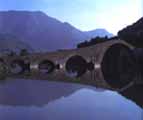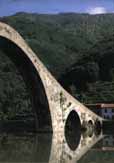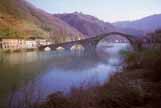
THE
DEVIL BRIDGE
| A reckless and courageous architectural building, saddlebacked, leans above the river Serchio with its asymmetrical arches, near the hamlet of Borgo a Mozzano. Its structural singularity has always sparked enthusiasm and curiosity among historians and art lovers, not only for the building's undoubted beauty, but also for the hardness of carrying it out, especially if we consider the remote age of the construction, probably to be inscribed in the 11th century. It seems that the bridge was built by the Countess Matilda, and it is named "Devil Bridge" for an old legend, or "of Maddalena" for a votive aedicule that preserves a S.Maddalena statue. The bridge was restored in the 14th century, during Castruccio Castracani's Lordship, and it is still almost perfectly undamaged. However, the building charm is undoubtedly spread by the legends that surround its origins story, which is still troubled by doubts, ambivalence and mysterious blanks. According to an old legend it seems that the builder, who wasn't able to manage the main arch construction, did implore the Devil to help him. So the Devil gave his help, carrying out the work in just a night, but he pretended to catch the first soul who would eventually pass on the bridge as a payment. The builder, astutely, set a pig to run on the bridge. So the Devil was fooled, obliged to settle for the soul of a beast, and he did disappear in the river Serchio water. Among many peoples and cultures, since primeval times, bridge building had been considered a hard and dangerous business to manage from a religious point of view, because a bridge artificially links what is naturally divided, so requiring for this matters some sacrifice or special ceremony (among ancient Romans one of the most important religious authority used to be the Pontifex Maximus, which means Supreme Bridge Builder, a title that is currently included in the Pope's names as supreme Pontiff). |


